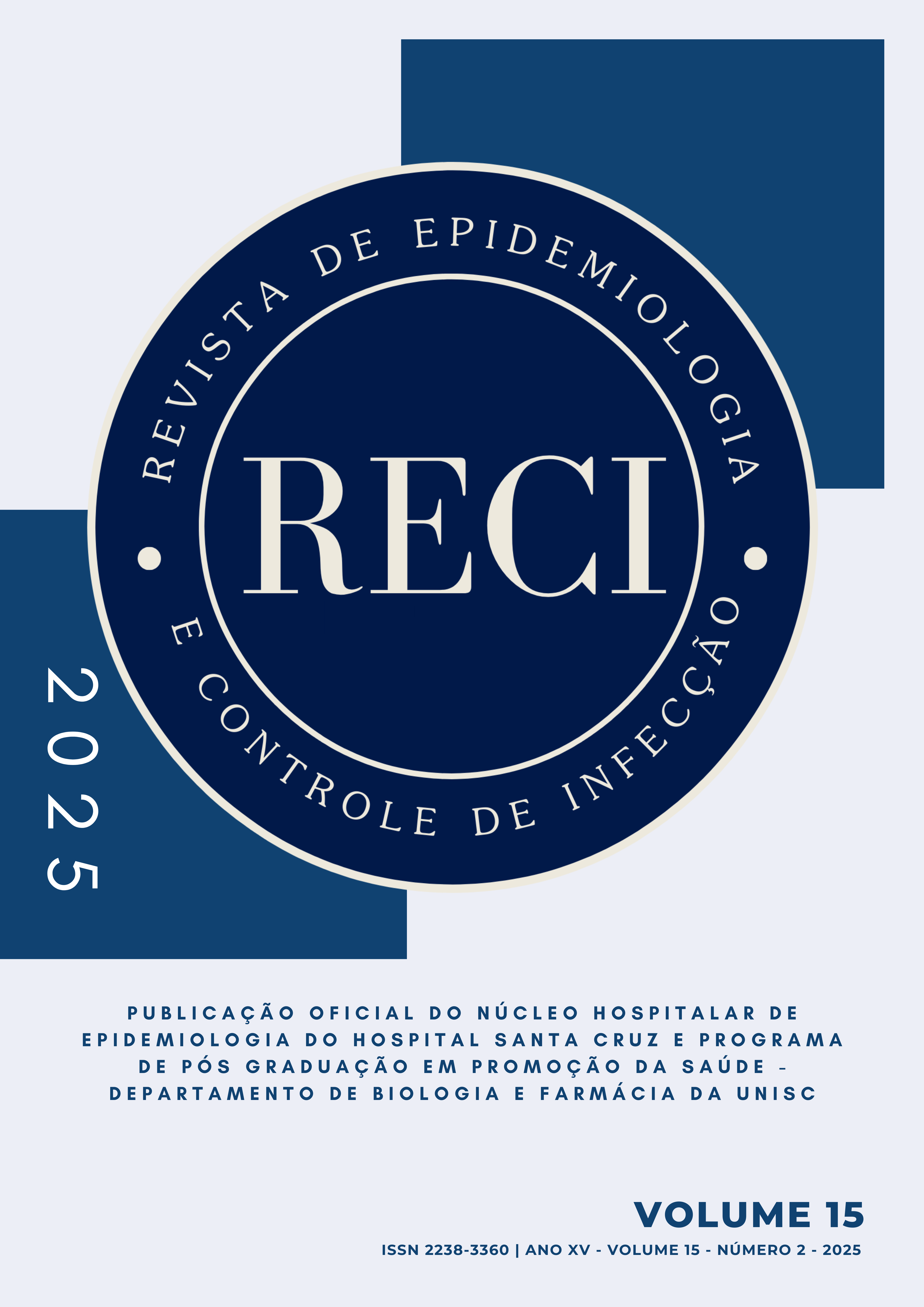Importância do diagnóstico diferencial em pacientes com Pneumonia Adquirida na Comunidade, em uso de drogas K-9 (spice)
DOI:
https://doi.org/10.17058/reci.v15i2.20061Palavras-chave:
Pneumonia; Pneumonite; Drogas ilícitas; Dependentes químicosResumo
A Pneumonia Adquirida na Comunidade (PAC) é uma condição de alta morbimortalidade, especialmente em usuários de drogas inalatórias. O uso da droga sintética K9 (spice) tem sido associado à pneumonite química, cujo quadro clínico pode ser confundido com infecções respiratórias, dificultando o diagnóstico e o manejo adequado. Este estudo relata o caso de um paciente masculino, 33 anos, com dependência química e uso recente de K9, internado com insuficiência respiratória grave. Foram realizados exames laboratoriais, tomografia computadorizada de tórax e pesquisa de agentes infecciosos por culturas microbiológicas e testes moleculares. O tratamento inicial incluiu antibioticoterapia empírica, suporte ventilatório invasivo e corticosteroides sistêmicos. A ausência de patógenos identificáveis e os achados radiológicos compatíveis levaram ao diagnóstico de pneumonite química induzida por K9. A terapia com corticosteroides promoveu melhora progressiva, permitindo a extubação e alta hospitalar após 24 dias, com encaminhamento para reabilitação. O caso destaca a importância de considerar drogas sintéticas no diagnóstico diferencial da PAC em indivíduos jovens com histórico de uso de substâncias, evitando o uso desnecessário de antibióticos e garantindo um tratamento mais direcionado. Além disso, evidencia a necessidade de capacitação profissional para o reconhecimento de padrões clínicos e radiológicos sugestivos de pneumonite química, bem como o desenvolvimento de políticas públicas voltadas à prevenção do consumo de drogas sintéticas e à mitigação de seus impactos na saúde pública.
Downloads
Referências
United Nations Office on Drugs and Crime (UNODC). World Drug Report 2023. Vienna: UNODC; 2023. Disponível em: https://www.unodc.org/unodc/en/data-and-analysis/world-drug-report-2023.html
Smith RJ, Thompson M, Garcia J. Effects of inhaled substances on pulmonary immunity: a review. Respir Med. 2021;175:106190. https://doi.org/10.1016/j.rmed.2020.106190
Ministério da Saúde. Sistema de Informação Hospitalar do SUS (SIH/SUS). Datasus; 2023. Disponível em: http://datasus.saude.gov.br
Oliveira AM, Santos MC, Pereira AC. Fatores de risco associados à pneumonia adquirida na comunidade no Brasil. J Bras Pneumol. 2022;48(1):e20210137. https://doi.org/10.36416/1806-3756/e20210137
Torres A, et al. Chemical pneumonitis: clinical characteristics and management. Eur Respir J. 2020;56(5):2000070. https://doi.org/10.1183/13993003.00070-2020
Zhang X, Li Y. Impact of inhaled drugs on lung function and immune response. Front Pharmacol. 2021;12:703914. https://doi.org/10.3389/fphar.2021.703914
Gonzalez JF, Perez D, Martinez R. Pulmonary toxicity related to illicit drugs: mechanisms and clinical presentations. Pulm Pharmacol Ther. 2022;74:102081. https://doi.org/10.1016/j.pupt.2021.102081
Jones L, et al. Synthetic cannabinoids: a review of pharmacology, toxicology, and public health impact. Drug Alcohol Depend. 2020;215:108199. https://doi.org/10.1016/j.drugalcdep.2020.108199
Williams K, et al. Respiratory complications from synthetic cannabinoid use: a clinical overview. Chest. 2021;159(3):1093-1101. https://doi.org/10.1016/j.chest.2020.09.007
Jain S, et al. Community-acquired pneumonia during COVID-19 pandemic: clinical challenges. J Infect Dis. 2021;223(10):1626-1634. https://doi.org/10.1093/infdis/jiaa742
Kim S, et al. Hospital outcomes of community-acquired pneumonia: influence of drug use and comorbidities. Clin Infect Dis. 2022;74(1):132-140. https://doi.org/10.1093/cid/ciab849
Lee N, et al. Differentiating COVID-19 pneumonia from other causes: clinical and radiological clues. Respir Med. 2021;182:106399. https://doi.org/10.1016/j.rmed.2021.106399
Polverino E, Torres A. Community-acquired pneumonia and novel drugs. Future Microbiol. 2015;10(11):1797-817. https://doi.org/10.2217/fmb.15.91
Torres A, et al. Advances in bacterial pneumonia diagnosis and treatment. Lancet Infect Dis. 2019;19(5):e155-e164. https://doi.org/10.1016/S1473-3099(18)30517-4
Wood DM, Dargan PI. Novel psychoactive substances: understanding acute toxicity. Ther Drug Monit. 2012;34(4):363-7. (Mantida pela relevância)
Seely KA, et al. Synthetic cannabinoids and severe pulmonary toxicity: clinical insights. Pulm Pharmacol Ther. 2023;77:102158. https://doi.org/10.1016/j.pupt.2022.102158
GBD 2016 Alcohol and Drug Use Collaborators. Global burden of disease attributable to substance use: a systematic analysis. Lancet Psychiatry. 2018;5(12):987-1012. https://doi.org/10.1016/S2215-0366(18)30337-7
Monteiro MG, et al. Drug policy and health system challenges: impact on respiratory disease burden. Rev Saude Publica. 2020;54:61. https://doi.org/10.11606/s1518-8787.2020054002340
Downloads
Publicado
Edição
Seção
Licença
Copyright (c) 2025 André, Álvaro, Larissa, Luis Gustavo, Luiz Paulo, Victor, Dra. Silvia

Este trabalho está licenciado sob uma licença Creative Commons Attribution 4.0 International License.
The author must state that the paper is original (has not been published previously), not infringing any copyright or other ownership right involving third parties. Once the paper is submitted, the Journal reserves the right to make normative changes, such as spelling and grammar, in order to maintain the language standard, but respecting the author’s style. The published papers become ownership of RECI, considering that all the opinions expressed by the authors are their responsibility. Because we are an open access journal, we allow free use of articles in educational and scientific applications provided the source is cited under the Creative Commons CC-BY license.


